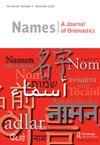歧义、回避和诉求:英国人名的头韵方面
IF 0.6
3区 文学
0 LANGUAGE & LINGUISTICS
引用次数: 4
摘要
在一些国家,当代婴儿命名最明显的趋势之一是选择一个相对不常见的名字。然而,尽管这是一个有据可查的现象,但对不常见名字使用的研究往往局限于名字。这项研究分析了1838年至2014年间来自英格兰的大约2200万个全名和来自威尔士的100万个全名。它提出了一种假设,即与选择一个不常见名字的当代愿望相一致,头韵名字——从定义上来说不常见——将变得越来越流行。更广泛地说,本研究描绘了头韵命名随时间的长期趋势。在英格兰和威尔士,这种模式与19世纪大部分时间的随机预期一致,但在整个20世纪显著下降,到20世纪70年代使用率最低。这种趋势在20世纪末发生了逆转,头韵命名在当代记录中变得更加普遍。头韵名称使用的这三个方面在主题上被称为“矛盾”、“回避”和“吸引”;这可能反映了人们对头韵命名态度的改变。20世纪末,头韵名字的相对重新流行,补充了之前对不常见名字的优势和当代命名“独特性”的需求的研究。本文章由计算机程序翻译,如有差异,请以英文原文为准。
Ambivalence, Avoidance, and Appeal: Alliterative Aspects of Anglo Anthroponyms
In several countries, one of the most pronounced trends in contemporary baby naming is selecting a comparatively uncommon name. Nevertheless, although a well-documented phenomenon, studies of uncommon name use are often limited to forenames. This study analyses approximately 22 million full names from England and 1 million from Wales, given between 1838 and 2014. It addresses the hypothesis that, consistent with the contemporary desire to choose an uncommon name, alliterative names – uncommon by definition – would become increasingly popular. More broadly, this study charts the long-term trends in alliterative naming over time. In both England and Wales, this pattern is consistent with a random expectation for much of the 19th century but declines significantly throughout the 20th century to its lowest use in the 1970s. This trend reverses towards the end of the 20th century, with alliterative naming becoming more common in contemporary records. These three aspects of alliterative name use are thematically referred to as ‘ambivalence’, ‘avoidance’ and ‘appeal’; and may reflect changing attitudes towards alliterative naming. The relatively renewed appeal of alliterative names towards the end of the 20th century complements previous research on the preponderance of uncommon names and the contemporary ‘need for uniqueness’ in naming.
求助全文
通过发布文献求助,成功后即可免费获取论文全文。
去求助
来源期刊

Names-A Journal of Onomastics
Multiple-
CiteScore
1.30
自引率
50.00%
发文量
23
期刊介绍:
Names, the journal of the American Name Society, is one of the world"s leading journals in the study of onomastics. Since the first issue in 1952, this quarterly journal has published hundreds of articles, reviews, and notes, seeking to find out what really is in a name, and to investigate cultural insights, settlement history, and linguistic characteristics revealed in names. Individuals subscribing to Names automatically become members of the American Name Society and receive the journal as part of their membership.
 求助内容:
求助内容: 应助结果提醒方式:
应助结果提醒方式:


